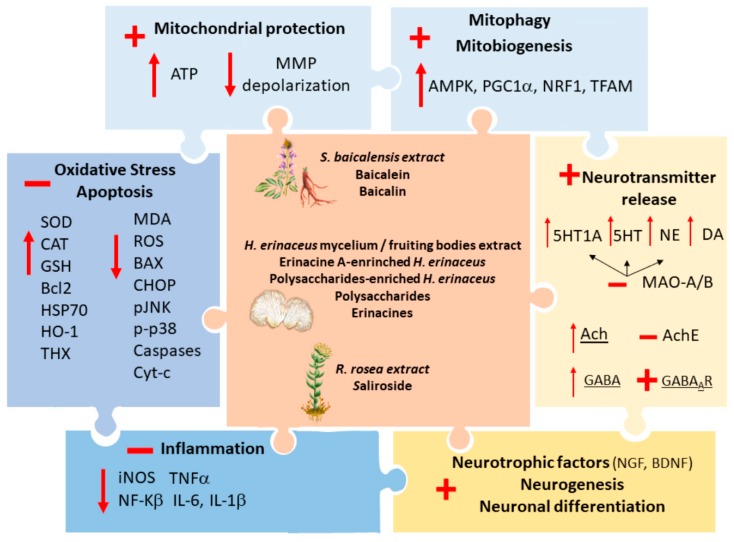Figure 3.
Mechanisms underlying the neuroprotective effects of S. baicalensis, H. erinaceus and R. rosea. The neuroprotective effects of S. baicalensis, H. erinaceus and R. rosea, administered as either full/enriched herbal extracts and/or as single bioactive ingredients (central box), are bound to antioxidant, mitochondrial-protecting, anti-inflammatory, neurotransmitter release-stimulating and neurotrophic/neurogenic activities. These effects are here represented as pieces of a puzzle where S. baicalensis, H. erinaceus and R. rosea perfectly fit in the middle. Antioxidant properties of these compounds consist of reducing the levels of reactive oxygen species (ROS), enhancing superoxide dismutase (SOD), glutathione (GSH) and catalase (CAT) activities along with heat shock proteins 70 (HSP70), heme oxygenase-1 (HO-1) and thioredoxin (THX) levels, while decreasing lipid peroxidation (malondialdehyde, MDA, content) and counteracting apoptosis through reduction of Bax, C/EBP Homologous Protein (CHOP), pJNK, pp38, caspases 3, 6 and 9, and cytochrome-c release. These effects are closely associated to mitochondrial protection, namely improvement of mitochondrial membrane potential (MMP) depolarization and ATP production, and concomitant enhancement of mitophagy and mitochondrial biogenesis via increasing 5’ AMP-activated protein kinase (AMPK), Peroxisome proliferator-activated receptor gamma coactivator 1-alpha (PGC1α), Nuclear respiratory factor 1 (NRF1) and Mitochondrial transcription factor A (TFAM). At the same time the three herbs promote anti-inflammatory effects by decreasing NF-kβ and iNOS enzymes levels while inhibiting the release of pro-inflammatory cytokines TNF-α, IL-6 and IL-1β. These herbs also target alterations of neurotransmitter systems, by enhancing the release of monoamine through MAO inhibition, acetylcholine (Ach) via inhibition of acetylcholine esterase (AchE), and GABA-induced inhibitory currents by promoting stimulation of GABAA receptors.

